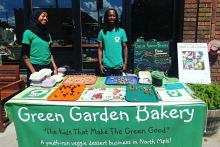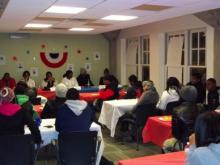Positive Youth Development in Mixed-Income Communities
Recent research has demonstrated the substantial relationship between life outcomes and the neighborhood in which one is raised. At NIMC, we have found that without intentional planning and implementation of youth development strategies, mixed-income environments alone do not necessarily promote positive youth outcomes and can, in fact, create additional challenges for low-income youth, particularly youth of color. Successful, inclusive mixed-income development should leverage the opportunity to break the generational cycle of poverty for low-income youth. Yet, few mixed-income developments have a comprehensive positive youth development strategy, customized to the specific opportunities and challenges inherent in a mixed-income setting.
In our State of the Field Scan titled Promoting Positive Youth Outcomes in Mixed-Income Developments, we highlight five mixed-income sites across the United States and Canada to share strategies and lessons learned from practitioners who have implemented promising youth development strategies.
Completed in 2020, the report was funded through generous support from the Annie E Casey Foundation.
- Profiles of the five sites
- Key Implications for Practitioners, Policymakers, and Funders
- Want to dig deeper?
Profiles of the five sites
Five mixed-income developments were selected for this scan because of their exemplary approaches to providing services, supports, and operating programs aimed explicitly to develop youth leadership and promote positive youth outcomes. These sites stand out for their carefully designed, well-resourced approaches to youth development, with staff dedicated to engaging youth in ways that enhance quality of life for youth as well as the broader community.
Heritage Park, Minneapolis, Minnesota
Heritage Park is a 440-unit mixed-income development completed in 2018. While Heritage Park provides a variety of programs aimed at children and youth, the signature youth-led program is the Green Garden Bakery, started in 2014 after a community needs assessment identified food insecurity as a major issue in Heritage Park and youth proposed an entrepreneurial venture to help address the problem. Youth now run the social enterprise with staff support.
New Columbia, Portland, Oregon
New Columbia is an 854-unit mixed-income development completed in 2014. The Housing Opportunities and Services Together (HOST) Demonstration, designed and funded by the Urban Institute, was implemented at New Columbia to test a two-generation service model that focuses on both parents and youth. A Youth Advisory Board has led the creation of a community food distribution program called Harvest Share managed entirely by youth.
Park Boulevard, Chicago, Illinois
Park Boulevard is a 367-unit mixed-income development opened in 2007 and is still under development. Community youth created a Youth Council that held elections each year and addressed issues that impacted youth of the new mixed-income development. A Safety Network Youth Leadership Program supported activities focused on mentoring, storytelling, and communication skills. A Parent Cafe and a Barber Shop were created for parents to build social support, relieve stress and have a safe space to discuss shared challenges with parenting youth.
Regent Park, Toronto, Canada
Regent Park is a mixed-income development in its third phase of development that will ultimately have over 7,000 units. A Revitalization Youth Ambassadors Forum was established in 2013 as a way for youth to be regularly engaged in the redevelopment process. The annual Forum, now organized each year by community youth, teaches youth about civic engagement, advocacy and event planning.
Villages of East Lake, Atlanta, Georgia
The Villages of East Lake is a 542-unit mixed-income development completed in 1995. The signature youth strategies in the community are the high-performing Drew Charter School, which was the first charter school in Atlanta, and First Tee of East Lake, a golf and empowerment program for youth. A YWCA provides additional comprehensive programming for community youth. East Lake’s success has led to the launch of the national Purpose Built Communities network of mixed-income communities.
Key Implications for Practitioners, Policymakers, and Funders
Leaders in these communities pointed to several key actions for mixed-income developments (including those in the planning stage, in development or those already completed) to take in order to ensure the most impactful outcomes for youth in particular and communities at large.
- Lead with a positive youth development frame
- Equip site staff and partners with tools to promote a youth-positive operating culture
- Cultivate strong partnerships with schools, youth organizations and police
- Prioritize youth participation and leadership
- Track and monitor youth outcomes and prioritize continuous improvement
- Anticipate the realities of complex race and social dynamics
Want to dig deeper?
For those committed to this work who want to dig deeper, below are additional resources with ideas, examples, and inspiration. Have a resource you’d like to add to the list? Please email Debbie Wilber.
- Our recent What Works to Promote Inclusive, Equitable, Mixed-Income Communities volume includes an incredible essay called Youth Voice and Leadership in Mixed-Income Communities which highlights the development of the Green Garden Bakery and key lessons learned.
- In July 2021, we followed up with two youth leaders at the Green Garden Bakery to hear how their experiences continued to impact their lives. One year after George Floyd's brutal murder not far away shook their community and our nation, these young people talk about the importance of using their voices, of personal growth, and of the transformative power of connectedness. Read more, In Their Voices.
- Urban Institute’s report Youth Engagement in Collective Impact Initiatives shares lessons learned from Promise Neighborhoods and discusses the importance of expanding youth voice and agency in this work.
- This article in Shelterforce tells the story of how one youth program in Boston flourished during the pandemic using specific tools and strategies used to continue meaningful engagement in the season of “social distancing”.
- Learn more about the Six C's of Positive Youth Development.
- Search Institute has identified 40 positive supports and strengths that young people need to succeed. Half of the assets focus on the relationships and opportunities they need in their families, schools, and communities (external assets). The remaining assets focus on the social-emotional strengths, values, and commitments that are nurtured within young people (internal assets).
- Learn more about positive youth development from organizations such as Search Institute, The Wallace Foundation, and Youth Power.
- Child Trends provides this useful definition of what positive youth development is and why it has proven to be effective.
- At the federal level, the U.S. Department of Health and Human Services encourages the use of a positive youth development approach as does the Centers for Disease Control and Prevention.
- The Child Welfare Information Gateway provides national, state and local examples of organizations and programs using a positive youth development approach.
- This brief, produced as a part of the Mixed-Income Development Study in collaboration with the University of Chicago School of Social Service Administration, reflects on some of the unexpected challenges faced by youth and the broader mixed-income community.
- This article by the Search Institute talks about how near peer relationships help young people develop social capital.




